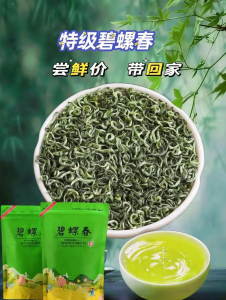Biluochun Tea
Biluochun, also known as “Dongting Biluochun”, is a precious green tea that ranks among the top ten famous teas in China. Its beautiful appearance, buds and leaves delicate, curled like a snail, covered with pekoe, soup color green and clear, fragrant flower, taste fresh and sweet, known as the “queen of tea”.
The origin and history of Biluochun
Biluochun has a long history, and its earliest cultivation can be traced back to the Tang Dynasty. At that time, Biluochun was listed as a tribute tea for the royal family to enjoy. In the Song Dynasty, Biluochun became even more famous and became the imperial tea for guests at court banquets. In the Ming and Qing Dynasties, the planting technology of Biluochun was continuously improved, the output gradually increased, and gradually went to the people, becoming the best tea that the common people can also taste.
Origin and characteristics of Biluochun
The main producing area of Biluochun is Dongting Mountain in Wu County, Suzhou City, Jiangsu Province, so it is also known as “Dongting Biluochun”. The steep terrain of Dongting Mountain, mild climate, abundant rain, fertile soil, very suitable for the growth of tea. The tea trees here are unique varieties, delicate buds and leaves, rich in theanine and aromatic substances, so the quality of Biluochun produced is excellent, renowned at home and abroad.
The uniqueness of Biluochun lies in its appearance, aroma, taste and soup color.
Appearance: The buds and leaves of Biluochun are delicate, curled like snails, covered with pekoe, shaped like “snails”, hence the name.
Aroma: Biluochun fragrant flower, with fresh fruit and honey aromas.
Taste: Biluochun tastes fresh and sweet with a long aftertaste.
Soup color: blue snail spring soup color green and clear, like the spring lake in general.
Production process of Biluochun
The production process of Biluochun is very fine, mainly including picking, withering, frying green, modeling and drying.
Picking: The picking time of Biluochun is very particular, generally around the Qingming Festival, when the tea tree buds and leaves are fresh and tender, and the quality is the best. When picking, one bud and one leaf must be selected, and picked gently and slowly to avoid damaging the tea.
Wilting: After picking, the tea leaves need to be wilted to remove water and promote the conversion of the contents.
Stir-frying green: stir-frying green is the core process of Biluochun production process, its purpose is to kill green through high temperature, passivation enzyme activity, to prevent tea from turning red. When frying green, it is necessary to master the heat and techniques to avoid frying old or tender.
Shape: The shape process of Biluochun is very unique, it is necessary to gently knead the tea leaves after frying, so that it forms a tight spiral.
Drying: Drying is the last process of Biluochun production, its purpose is to remove the residual water in the tea, reduce the moisture content, in order to facilitate preservation.
Brewing method of Biluochun
The brewing method of Biluochun is more particular, and the water temperature, water quality, tea pouring amount and brewing time need to be paid attention to.
Water temperature: When brewing Biluochun, the water temperature should not be too high, generally 70-80 degrees Celsius is appropriate. The water temperature is too high, will destroy the contents of the tea, resulting in bitter tea.
Water quality: When brewing Biluochun, pure mountain spring or mineral water should be selected, and tap water should be avoided. Tap water contains impurities such as chlorine, which can affect the taste of tea.
Amount of tea: The amount of tea in Biluochun should not be too much, generally each gram of tea can brew 50 ml of water. Too much tea, too high concentration of tea soup, will appear bitter.
Brewing time: When brewing Biluochun, tea leaves should be put into a teacup first, and then poured into hot water. The brewing time should not be too long, generally 30 seconds to 1 minute is appropriate. Brewing time is too long, the bitter substances in the tea will precipitate, affecting the taste.

The effect of Biluochun and drinking precautions
Biluochun is rich in tea polyphenols, caffeine, amino acids, vitamins and other nutrients, and has a variety of health effects on the human body.
Biluochun is good, but not suitable for everyone to drink. The following groups should pay attention:
Pregnant women and lactating women: Biluochun caffeine has the effect of excitatory nerves, pregnant women and lactating women drink too much, may cause fetal or infant unease.
Neurasthenia: Biluochun caffeine has the effect of excitatory nerves, neurasthenia drinking too much, may aggravate the condition.
Patients with gastrointestinal diseases: caffeine and tea polyphenols in Biluochun will stimulate the gastrointestinal tract, and patients with gastrointestinal diseases may drink too much, which may aggravate the condition.
Biluochun selection method
The appearance, aroma, taste and color of Biluochun are important manifestations of its quality. When purchasing Biluochun, we should pay attention to:
Appearance: The buds and leaves of Biluochun should be tender and complete, curled like a snail, covered with pekoe.
Aroma: The fragrance of Biluochun should be fragrant like flowers, with fresh fruit and honey.
Taste: Biluochun taste should be fresh and sweet, long aftertaste.
Soup color: blue snail spring soup color should be green and clear, like the lake in spring.